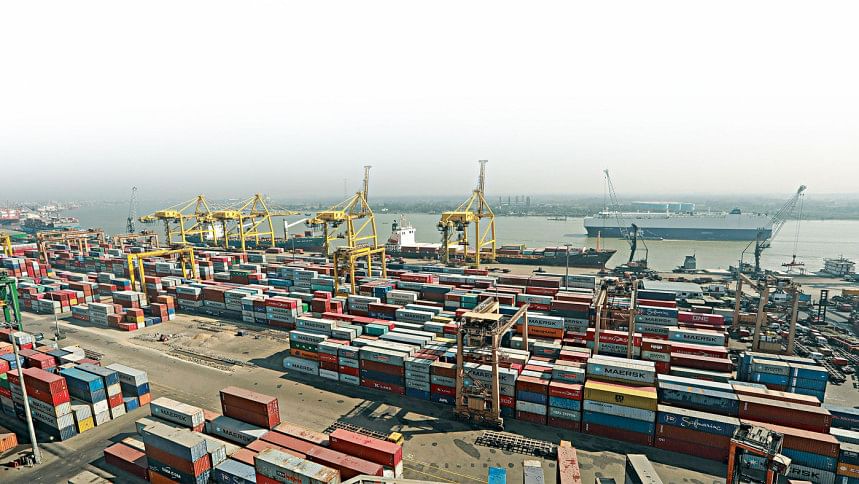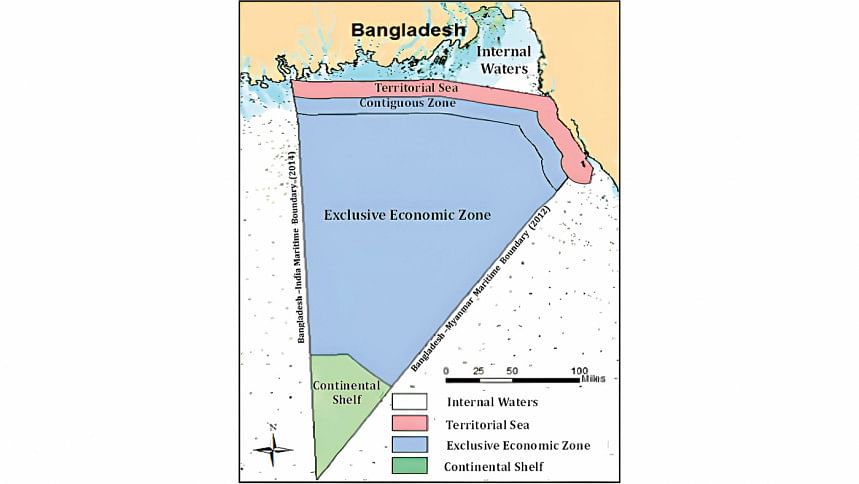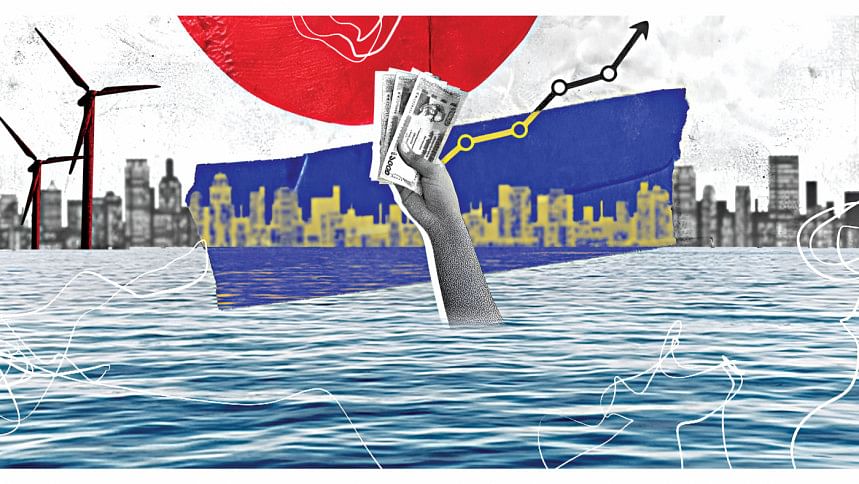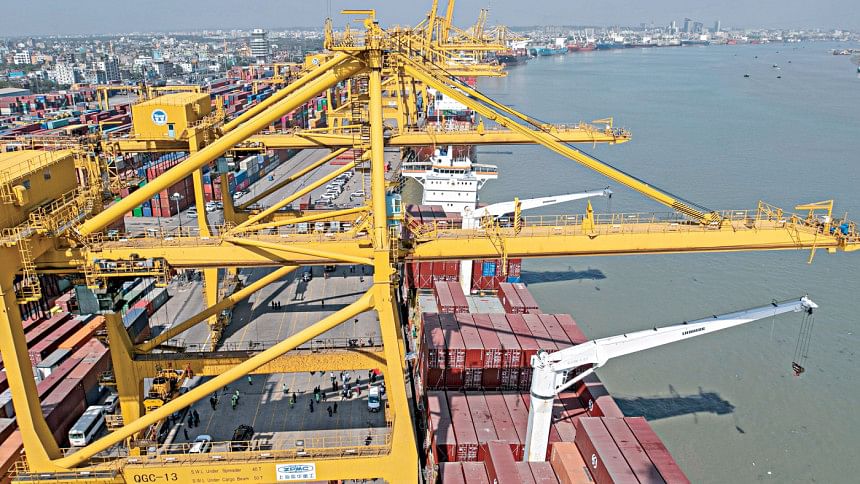Utilization of marine resources for the benefit of Bangladesh

Oceans, covering 71% of the planet's surface and containing 97% of its water, serve as a sanctuary for 2.2 million species. The utilization of marine resources, encompassed by the Blue Economy, aims to bolster economic growth by sustainably harnessing oceanic resources to foster social inclusion, enhance livelihoods, and meet increasing job demands while ensuring the environmental sustainability of ocean and coastal waters. This approach supports food security, the management and protection of marine environments, the creation of high-value employment opportunities, and diversification to exploit new resources such as energy, pharmaceuticals, protein sources, deep-sea minerals, security services for human welfare, and measures to combat climate change resilience. The estimated value-added output of the ocean-based Blue Economy exceeds 1.5 trillion USD, representing approximately 2.5% of the world's gross economic value.

Overall, the marine fisheries sector contributes a substantial $230 billion to the global economy, directly or indirectly supporting the livelihoods of 9% of the world's population. Additionally, oceans serve as vital transportation routes, facilitating approximately 80% of global trade in goods. Coastal tourism plays a pivotal role in driving economic growth for numerous coastal and island nations, generating an annual revenue of about $161 billion globally. Furthermore, the emerging field of "ocean energy," including aquatic biofuels and renewable energies, holds promise as a significant future source to meet the world's energy demands. The ocean also harbors potential for various valuable industrial products such as pharmaceuticals, antibiotics, antifreeze, and antifouling paints. However, looking ahead to the mid-century, meeting the needs for food, jobs, energy, raw materials, and economic growth will be essential to sustain an anticipated population level of between 9 and 10 billion people.
Bangladesh's coastal areas boast unique attractions, including Cox's Bazar, the world's longest sea beach, and the Sundarbans, the largest mangrove forest globally. However, the potential of coastal and marine tourism remains largely untapped, as reflected in Bangladesh's tourism and recreation performance score, currently standing at only 8%.
Bangladesh is endowed with a vast marine ecosystem. Following an international legal ruling, led by Prime Minister Sheikh Hasina, on disputed maritime areas with neighboring countries India and Myanmar, Bangladesh's maritime territory is estimated to cover 118,813 sq. km, including a continental shelf spanning approximately 37,000 sq. km with depths of up to 50m. Bangladesh boasts rich reserves of both living and non-living resources in its extended coastal and maritime areas, presenting significant opportunities for development. The United Nations Sustainable Development agenda prioritizes the conservation, sustainability, and utilization of oceans, seas, and marine resources, particularly for the benefit of least developed countries. This agenda emphasizes sustainable management practices for fisheries, aquaculture, and tourism, aiming to maximize economic benefits while preserving marine ecosystems for future generations.

Non-living resources in Bangladesh's coastal areas encompass oil, gas, sea salt, and freshwater. Renewable resources, vital for sustainable development, include wind, water current, and solar energy. These resources support various sectors such as maritime transport, tourism, industries, ports, shipyards, shipbreaking, agriculture, aquaculture, islands, coastal protection, carbon storage, and waste disposal. Among living coastal resources, mangroves stand out as the second most important in Bangladesh. The coastal region boasts an impressive 531,000 hectares of mangroves, with 99,000 hectares designated as 'the Sunderbans'. These ecosystems harbor 345 plant species of 245 genera, with significant economic value. Additionally, the mangrove habitat supports a diverse array of wildlife, including 53 species of pelagic fish, 124 species of demersal fish, 24 shrimp species, 58 wildlife species, and 270 bird species.
Saint Martin's Island, covering approximately 7.5 square kilometers, stands as Bangladesh's sole coral-bearing island. Researchers have identified four coral species belonging to the Acropora genus and documented 66 coral species in total. Furthermore, the island boasts a rich diversity of seaweeds, with around 20-22 species present, the most abundant being Hypnea.
Establishing a robust set of mandatory environmental regulations to promote sustainable use of marine resources across all operational domains is imperative. Additionally, developing localized strategies to bolster a sustainable blue economy falls within the purview of ocean governance initiatives.
The nearshore and offshore regions along Bangladesh's coast hold potential reserves of oil, gas, and commercially important heavy minerals. Notably, 17 deposits containing valuable minerals such as Zircon, Rutile, Ilmenite, Leucoxene, Kyanite, Garnet, Magnetite, and Monazite have been discovered in beach sands stretching from Patenga to Teknaf. Sea salt production through solar evaporation techniques presents another economic opportunity, with approximately 67,757 hectares utilized for salt cultivation in coastal areas. Despite this, Bangladesh still imports salt, indicating the potential for further increasing domestic production to meet demand.
Bangladesh's coastal areas boast unique attractions, including Cox's Bazar, the world's longest sea beach, and the Sundarbans, the largest mangrove forest globally. However, the potential of coastal and marine tourism remains largely untapped, as reflected in Bangladesh's tourism and recreation performance score, currently standing at only 8%. Additionally, the country's commercial use of marine waters is facilitated through four international ports: Chittagong, Payra, Matarbari, and Mongla.

A comprehensive assessment of all marine resources in Bangladesh is hindered by data limitations. The total marine fish catch reached 564,687 tons during 2017-18, accounting for 16% of the total fish production. Both inland and marine fish catches have shown a long-term increase. Over 0.8 million individuals are directly and indirectly involved in the marine fisheries sector for their livelihoods. Presently, there are 225 industrial trawlers, including 24 mid-water trawlers, and approximately 38,000 mechanized and non-mechanized boats operating in marine waters. However, deep-sea and tuna fishing are nonexistent. Bangladesh boasts the world's largest shipbreaking industry, employing over 200,000 people. Currently, 10,000 inland and coastal ships, along with 102 foreign-going vessels, transport more than 90% of total oil products, 80% of cargo, and 35% of passengers domestically and internationally. The country also hosts over 10 shipyards constructing ships of international standards.
In Cox's Bazar, approximately 263 square kilometers of land and around 20 square kilometers in Chittagong are dedicated to sea salt production. This sector generates over 5 million jobs and contributes approximately $35,313,000 to $41,198,500 annually to the national economy. A target of producing 1.8 million tons of salt annually from a 247 square kilometer area in Cox's Bazar has been set, sufficient to meet domestic demand. Salinity in salt pans provides an ideal environment for artemia culture and cyst production, with a current market price ranging from $50 to $100 per kilogram.
In Bangladesh, it is projected that 40% of productive land in the southern region could be lost due to a 65cm sea-level rise by the 2080s, affecting approximately 20 million people already grappling with saline water intrusion impacting their drinking water supply. Moreover, approximately 1 million hectares of land in southern coastal areas are at risk from saline water intrusion.
Seaweed cultivation costs $2.4 per square meter, with cultivated seaweed selling at $7.8 per square meter, yielding a net profit of $5.4 per square meter. Hence, only 34 square meters of seaweed cultivable area would suffice to cover the monthly expenses of a typical family. Non-target marine fish species like goby fish can be utilized for poultry feed production, with approximately 11,185 metric tons of prawn grow-out feed producible from 3,699 metric tons of dried goby fish, selling at $0.24 to $0.25 per kilogram.

Additionally, with a wind velocity of 7.34 meters per second, the extractable wind energy through windmills amounts to 0.0279 kilowatt-hours from a 1 square meter area. Thus, a family would require approximately 8,853 square meters to meet their monthly electricity demand of 247 kilowatt-hours. In Bangladesh's coastal areas, daily sunshine hours vary between 3 to 11 hours, with insolation ranging from 3.8 to 6.4 kilowatt-hours per square meter per day on average. Therefore, solar panels covering a 50 square meter area would suffice for a family's household electricity needs. Additionally, tidal and wave energy, with tidal ranges of 4 to 5 meters and wave heights of 0.5 to 2.4 meters respectively, present further renewable energy options in coastal areas.
The coastal region harbors islands with significant economic potential, offering opportunities for innovative management approaches. One such approach is the conversion of existing islands into "Model Islands." This concept involves optimizing economic returns by strategically utilizing multiple resources with available technological inputs while preserving the environmental integrity of the islands. Desalination of water emerges as a viable solution, particularly for remote and rural areas where small quantities of potable water are required. Solar stills, such as the single-effect basin-type, have traditionally been the most cost-effective method for producing drinkable water using solar energy. Although daily production is limited due to latent heat condensation rejection, typically yielding less than 4–5 liters per square meter with a specific energy consumption of around 7000 kJ/kg, the implementation of appropriate techniques can yield significant economic benefits in this sector.
Promoting the blue economy and advancing Sustainable Development Goals (SDGs), especially SDG 14, are closely intertwined objectives. Therefore, marine resources should be integrated into development planning at both local and national levels to foster the blue economy and achieve SDGs. The escalating pressures from population growth and the increasing demands for jobs and food underscore the urgency of aligning development efforts with SDGs.
Ocean governance entails managing and utilizing ocean resources in a manner that ensures the ocean's health, productivity, safety, security, and resilience. Adopting a holistic approach that addresses all marine and maritime issues is essential for effective ocean governance in Bangladesh. Establishing a robust set of mandatory environmental regulations to promote sustainable use of marine resources across all operational domains is imperative. Additionally, developing localized strategies to bolster a sustainable blue economy falls within the purview of ocean governance initiatives.
The Chittagong port annually handles over 4000 ships and 100 oil tankers, while the Mongla port manages about 1000 ships. Approximately 3000 power-driven trawlers and boats operate in fishing and shrimping activities within the Bay of Bengal. However, shipbreaking activities in Chittagong result in the discharge of significant quantities of heavy metals, waste oil, and other pollutants during washing and dismantling operations. Oil spills from ships have severe consequences on the biotic community, particularly mangroves, which are highly susceptible to oil exposure, leading to their deterioration and potential death within weeks to months.
Research activities play a crucial role in fostering the certainty and security of sustainable blue economy growth. Priorities include enhancing ocean literacy to improve understanding of marine information, spatial planning for efficient and sustainable management of sea-based activities, and maritime monitoring to gain insights into oceanic dynamics. To implement this framework effectively, integration of existing institutions is essential, and the establishment of a multidisciplinary maritime division, drawing from the experience of the Blue Economy Cell over the past decade, is recommended. Identifying bottlenecks will further facilitate cooperation, coordination, and exchange of best practices for sustainable blue economy management.
Coastal and maritime tourism, fueled by the extraordinary beauty and rich diversity of coastal areas, has emerged as a crucial sector attracting both domestic and international holidaymakers. Strengthening the blue economy serves as a long-term strategy for promoting sustainable economic development and ensuring livelihood security in Bangladesh. By harnessing proper strategies, the full potential of the blue economy can be realized, making the marine ecosystem a primary driver of the national economy. However, achieving a sustainable blue economy necessitates the development of a strategic planning and management framework, with a particular focus on sectors with high economic potential such as fisheries, shipping, shipbuilding, coastal and maritime tourism, marine biotechnology, ocean energy, mangrove forest preservation, and renewable resources. These efforts are integral to fostering smart, sustainable, and inclusive economic development in Bangladesh.

 For all latest news, follow The Daily Star's Google News channel.
For all latest news, follow The Daily Star's Google News channel. 



Comments